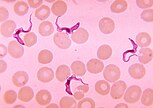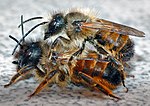Sinh vật nhân thực
| Sinh vật nhân thực | |
|---|---|
| Thời điểm hóa thạch: Kỷ Statheros–Hiện tại 1650–0 Ma Had'n Archean Proterozoic Pha. | |
| Phân loại khoa học | |
| (không phân hạng) | Sự sống tế bào |
| Liên vực (superdomain) | Eukaryote |
| Vực (domain) | Eukarya Whittaker & Margulis,1978 |
| Các phân vực và giới[2] | |
| Danh pháp đồng nghĩa | |
Hộp này:
| ||||||||||||||||||||||||||||
−4500 — – — – −4000 — – — – −3500 — – — – −3000 — – — – −2500 — – — – −2000 — – — – −1500 — – — – −1000 — – — – −500 — – — – 0 — | Sinh vật nhân thực T h ự c v ậ t H. t h à n h T h á i c ổ N g u y ê n s i n h H. s i n h |
| ||||||||||||||||||||||||||
Sinh vật nhân thực, còn gọi là sinh vật nhân chuẩn, sinh vật nhân điển hình hoặc sinh vật có nhân chính thức (danh pháp: Eukaryote hay Eukarya)[5] là nhóm những sinh vật có các tế bào phức tạp, trong đó vật liệu di truyền được sắp đặt trong nhân có màng bao bọc. Eukaryote là chữ Latin có nghĩa là có nhân thật sự.
Sinh vật nhân thực gồm có động vật, thực vật và nấm - hầu hết chúng là sinh vật đa bào - cũng như các nhóm đa dạng khác được gọi chung là nguyên sinh vật (đa số là sinh vật đơn bào, bao gồm động vật nguyên sinh và thực vật nguyên sinh). Trái lại, các sinh vật khác, chẳng hạn như vi khuẩn, không có nhân và các cấu trúc tế bào phức tạp khác; những sinh vật như thế được gọi là sinh vật tiền nhân hoặc sinh vật nhân sơ (prokaryote). Sinh vật nhân thực có cùng một nguồn gốc và thường được xếp thành một siêu giới hoặc vực (domain).
Các sinh vật này thường lớn gấp 10 lần (về kích thước) so với sinh vật nhân sơ, do đó gấp khoảng 1000 lần về thể tích. Điểm khác biệt quan trọng giữa sinh vật nhân sơ và sinh vật nhân thực là tế bào nhân thực có các xoang tế bào được chia nhỏ do các lớp màng tế bào để thực hiện các hoạt động trao đổi chất riêng biệt. Trong đó, điều tiến bộ nhất là việc hình thành nhân tế bào có hệ thống màng riêng để bảo vệ các phân tử DNA của tế bào. Tế bào sinh vật nhân thực thường có những cấu trúc chuyên biệt để tiến hành các chức năng nhất định, gọi là các bào quan. Các đặc trưng gồm:
- Tế bào chất của sinh vật nhân thực thường không nhìn thấy những thể hạt như ở sinh vật nhân sơ vì rằng phần lớn ribosome của chúng được bám trên mạng lưới nội chất.
- Màng tế bào cũng có cấu trúc tương tự như ở sinh vật nhân sơ tuy nhiên thành phần cấu tạo chi tiết lại khác nhau một vài điểm nhỏ. Chỉ một số tế bào sinh vật nhân thực có thành tế bào.
- Vật chất di truyền trong tế bào sinh vật nhân thực thường gồm một hoặc một số phân tử DNA mạch thẳng, được cô đặc bởi các protein histone tạo nên cấu trúc nhiễm sắc thể. Mọi phân tử DNA được lưu giữ trong nhân tế bào với một lớp màng nhân bao bọc. Một số bào quan của sinh vật nhân thực có chứa DNA riêng.
- Một vài tế bào sinh vật nhân thực có thể di chuyển nhờ tiên mao. Những tiên mao thường có cấu trúc phức tạp hơn so với sinh vật nhân sơ.
Phát sinh loài[6][7]
| Eukaryotes |
| ||||||||||||||||||||||||||||||||||||||||||||||||||||||||||||||||||||||||||||||||||||||||||||||||
Nghiên cứu
Trong một số nghiên cứu, Hacrobia nhóm (Haptophyta + Cryptophyta) này đặt kế Archaeplastida,[8] nhưng ở những người khác, nó được phân vào bên trong Archaeplastida.[9] Tuy nhiên, một số nghiên cứu gần đây đã kết luận rằng Haptophyta và Cryptophyta không tạo thành nhóm đơn ngành.[10] Trước đây có thể là một nhóm chị em với SAR, sau này nhóm với Archaeplastida (thực vật nghĩa rộng).[11]
Sự phân chia của Eukaryota thành hai nhánh chính, bikonta (Archaeplastida + SAR + Excavata) và Unikonta (Amoebozoa + Opisthokonta), nguồn gốc từ một nhóm tổ tiên biflagellar (hai roi) và một nhóm sinh vật tổ tiên uniflagellar, tương ứng, đã được đề xuất trước đó.[9][12][13] Năm 2012 nghiên cứu tạo ra một sự phân chia hơi giống nhau, mặc dù lưu ý rằng các nghiên cứu "unikonta" và "bikonta" không được sử dụng theo nghĩa ban đầu.[14][15][16][17][18][19][20][21][22][23][24]
| ||||||||||||||||||||||||||||||||||||||||||||||||||||||||||||||||||||||||||||||||||||||||
Cây phát sinh của Cavalier-Smith's
Thomas Cavalier-Smith 2010,[25] 2013,[26] 2014,[27] 2017[16] và năm 2018[28] đặt nhóm eukaryota gốc giữa Excavata và không có rãnh Euglenozoa, và đơn ngành Chromista, liên quan đến một sự kiện nội cộng sinh duy nhất của việc bắt một loài tảo đỏ. Ông ấy và cộng sự.[29]
| Eukaryotes |
| ||||||||||||||||||||||||||||||||||||||||||||||||||||||||||||||||||||||||||||||||||||||||||||||||||||||
Xem thêm
Hình ảnh
Tham khảo
- ^ Lỗi chú thích: Thẻ
<ref>sai; không có nội dung trong thẻ ref có tênProvora - ^ Adl, S.M. et al. 2005: The new higher level classification of eukaryotes with emphasis on the taxonomy of protists. Journal of eukaryotic microbiology, 52: 399–451. doi: 10.1111/j.1550-7408.2005.00053.
- ^ Lỗi chú thích: Thẻ
<ref>sai; không có nội dung trong thẻ ref có tênw1990 - ^ Lỗi chú thích: Thẻ
<ref>sai; không có nội dung trong thẻ ref có tênMargulis 1996 - ^ “Eukaryota.Uniprot.org(Taxonomy 2759)”.
- ^ Adl SM, Bass D, Lane CE, Lukeš J, Schoch CL, Smirnov A, và đồng nghiệp (tháng 1 năm 2019). “Revisions to the Classification, Nomenclature, and Diversity of Eukaryotes”. The Journal of Eukaryotic Microbiology. 66 (1): 4–119. doi:10.1111/jeu.12691. PMC 6492006. PMID 30257078.
- ^ Schön ME, Zlatogursky VV, Singh RP, Poirier C, Wilken S, Mathur V, và đồng nghiệp (2021). “Picozoa are archaeplastids without plastid”. Nature Communications. 12 (1). doi:10.1101/2021.04.14.439778. S2CID 233328713.
- ^ Burki F, Shalchian-Tabrizi K, Minge M, Skjaeveland A, Nikolaev SI, Jakobsen KS, Pawlowski J (tháng 8 năm 2007). Butler G (biên tập). “Phylogenomics reshuffles the eukaryotic supergroups”. PLOS ONE. 2 (8): e790. Bibcode:2007PLoSO...2..790B. doi:10.1371/journal.pone.0000790. PMC 1949142. PMID 17726520.
- ^ a b Kim E, Graham LE (tháng 7 năm 2008). Redfield RJ (biên tập). “EEF2 analysis challenges the monophyly of Archaeplastida and Chromalveolata”. PLOS ONE. 3 (7): e2621. Bibcode:2008PLoSO...3.2621K. doi:10.1371/journal.pone.0002621. PMC 2440802. PMID 18612431.
- ^ Baurain D, Brinkmann H, Petersen J, Rodríguez-Ezpeleta N, Stechmann A, Demoulin V, Roger AJ, Burger G, Lang BF, Philippe H (tháng 7 năm 2010). “Phylogenomic evidence for separate acquisition of plastids in cryptophytes, haptophytes, and stramenopiles”. Molecular Biology and Evolution. 27 (7): 1698–1709. doi:10.1093/molbev/msq059. PMID 20194427.
- ^ Burki F, Okamoto N, Pombert JF, Keeling PJ (tháng 6 năm 2012). “The evolutionary history of haptophytes and cryptophytes: phylogenomic evidence for separate origins”. Proceedings: Biological Sciences. 279 (1736): 2246–2254. doi:10.1098/rspb.2011.2301. PMC 3321700. PMID 22298847.
- ^ Cavalier-Smith T (2006). “Protist phylogeny and the high-level classification of Protozoa”. European Journal of Protistology. 39 (4): 338–348. doi:10.1078/0932-4739-00002. S2CID 84403388.
- ^ Burki F, Pawlowski J (tháng 10 năm 2006). “Monophyly of Rhizaria and multigene phylogeny of unicellular bikonts”. Molecular Biology and Evolution. 23 (10): 1922–1930. doi:10.1093/molbev/msl055. PMID 16829542.
- ^ Zhao S, Burki F, Bråte J, Keeling PJ, Klaveness D, Shalchian-Tabrizi K (tháng 6 năm 2012). “Collodictyon – an ancient lineage in the tree of eukaryotes”. Molecular Biology and Evolution. 29 (6): 1557–1568. doi:10.1093/molbev/mss001. PMC 3351787. PMID 22319147.
- ^ Ren R, Sun Y, Zhao Y, Geiser D, Ma H, Zhou X (tháng 9 năm 2016). “Phylogenetic Resolution of Deep Eukaryotic and Fungal Relationships Using Highly Conserved Low-Copy Nuclear Genes”. Genome Biology and Evolution. 8 (9): 2683–2701. doi:10.1093/gbe/evw196. PMC 5631032. PMID 27604879.
- ^ a b Cavalier-Smith T (tháng 1 năm 2018). “Kingdom Chromista and its eight phyla: a new synthesis emphasising periplastid protein targeting, cytoskeletal and periplastid evolution, and ancient divergences”. Protoplasma. 255 (1): 297–357. doi:10.1007/s00709-017-1147-3. PMC 5756292. PMID 28875267.
- ^ Derelle R, Torruella G, Klimeš V, Brinkmann H, Kim E, Vlček Č, Lang BF, Eliáš M (tháng 2 năm 2015). “Bacterial proteins pinpoint a single eukaryotic root”. Proceedings of the National Academy of Sciences of the United States of America. 112 (7): E693–699. Bibcode:2015PNAS..112E.693D. doi:10.1073/pnas.1420657112. PMC 4343179. PMID 25646484.
- ^ Yang J, Harding T, Kamikawa R, Simpson AG, Roger AJ (tháng 5 năm 2017). “Mitochondrial Genome Evolution and a Novel RNA Editing System in Deep-Branching Heteroloboseids”. Genome Biology and Evolution. 9 (5): 1161–1174. doi:10.1093/gbe/evx086. PMC 5421314. PMID 28453770.
- ^ Cavalier-Smith T, Fiore-Donno AM, Chao E, Kudryavtsev A, Berney C, Snell EA, Lewis R (tháng 2 năm 2015). “Multigene phylogeny resolves deep branching of Amoebozoa”. Molecular Phylogenetics and Evolution. 83: 293–304. doi:10.1016/j.ympev.2014.08.011. PMID 25150787.
- ^ Lỗi chú thích: Thẻ
<ref>sai; không có nội dung trong thẻ ref có tênBrown_2018 - ^ Torruella G, de Mendoza A, Grau-Bové X, Antó M, Chaplin MA, del Campo J, Eme L, Pérez-Cordón G, Whipps CM, Nichols KM, Paley R, Roger AJ, Sitjà-Bobadilla A, Donachie S, Ruiz-Trillo I (tháng 9 năm 2015). “Phylogenomics Reveals Convergent Evolution of Lifestyles in Close Relatives of Animals and Fungi”. Current Biology. 25 (18): 2404–2410. doi:10.1016/j.cub.2015.07.053. PMID 26365255.
- ^ Ponce-Toledo RI, Deschamps P, López-García P, Zivanovic Y, Benzerara K, Moreira D (tháng 2 năm 2017). “An Early-Branching Freshwater Cyanobacterium at the Origin of Plastids”. Current Biology. 27 (3): 386–391. doi:10.1016/j.cub.2016.11.056. PMC 5650054. PMID 28132810.
- ^ de Vries J, Archibald JM (tháng 2 năm 2017). “Endosymbiosis: Did Plastids Evolve from a Freshwater Cyanobacterium?”. Current Biology. 27 (3): R103–105. doi:10.1016/j.cub.2016.12.006. PMID 28171752.
- ^ López-García P, Eme L, Moreira D (tháng 12 năm 2017). “Symbiosis in eukaryotic evolution”. Journal of Theoretical Biology. 434: 20–33. Bibcode:2017JThBi.434...20L. doi:10.1016/j.jtbi.2017.02.031. PMC 5638015. PMID 28254477.
- ^ Cavalier-Smith T (tháng 6 năm 2010). “Kingdoms Protozoa and Chromista and the eozoan root of the eukaryotic tree”. Biology Letters. 6 (3): 342–345. doi:10.1098/rsbl.2009.0948. PMC 2880060. PMID 20031978.
- ^ Cavalier-Smith T (tháng 5 năm 2013). “Early evolution of eukaryote feeding modes, cell structural diversity, and classification of the protozoan phyla Loukozoa, Sulcozoa, and Choanozoa”. European Journal of Protistology. 49 (2): 115–178. doi:10.1016/j.ejop.2012.06.001. PMID 23085100.
- ^ Cavalier-Smith T, Chao EE, Snell EA, Berney C, Fiore-Donno AM, Lewis R (tháng 12 năm 2014). “Multigene eukaryote phylogeny reveals the likely protozoan ancestors of opisthokonts (animals, fungi, choanozoans) and Amoebozoa”. Molecular Phylogenetics and Evolution. 81: 71–85. doi:10.1016/j.ympev.2014.08.012. PMID 25152275.
- ^ Cavalier-Smith T, Chao EE, Lewis R (tháng 4 năm 2018). “Multigene phylogeny and cell evolution of chromist infrakingdom Rhizaria: contrasting cell organisation of sister phyla Cercozoa and Retaria”. Protoplasma. 255 (5): 1517–1574. doi:10.1007/s00709-018-1241-1. PMC 6133090. PMID 29666938.
- ^ He D, Fiz-Palacios O, Fu CJ, Fehling J, Tsai CC, Baldauf SL (tháng 2 năm 2014). “An alternative root for the eukaryote tree of life”. Current Biology. 24 (4): 465–470. doi:10.1016/j.cub.2014.01.036. PMID 24508168.
Liên kết ngoài
 Dữ liệu liên quan tới Eukaryota tại Wikispecies
Dữ liệu liên quan tới Eukaryota tại Wikispecies Tư liệu liên quan tới Eukaryota tại Wikimedia Commons
Tư liệu liên quan tới Eukaryota tại Wikimedia Commons- Eukaryote tại Encyclopædia Britannica (tiếng Anh)
- Eukaryotes (Tree of Life web site) Lưu trữ 2012-01-29 tại Wayback Machine
- Prokaryote versus eukaryote, BioMineWiki Lưu trữ 2012-10-25 tại Wayback Machine
 | Bài viết về chủ đề sinh học này vẫn còn sơ khai. Bạn có thể giúp Wikipedia mở rộng nội dung để bài được hoàn chỉnh hơn.
|

















































